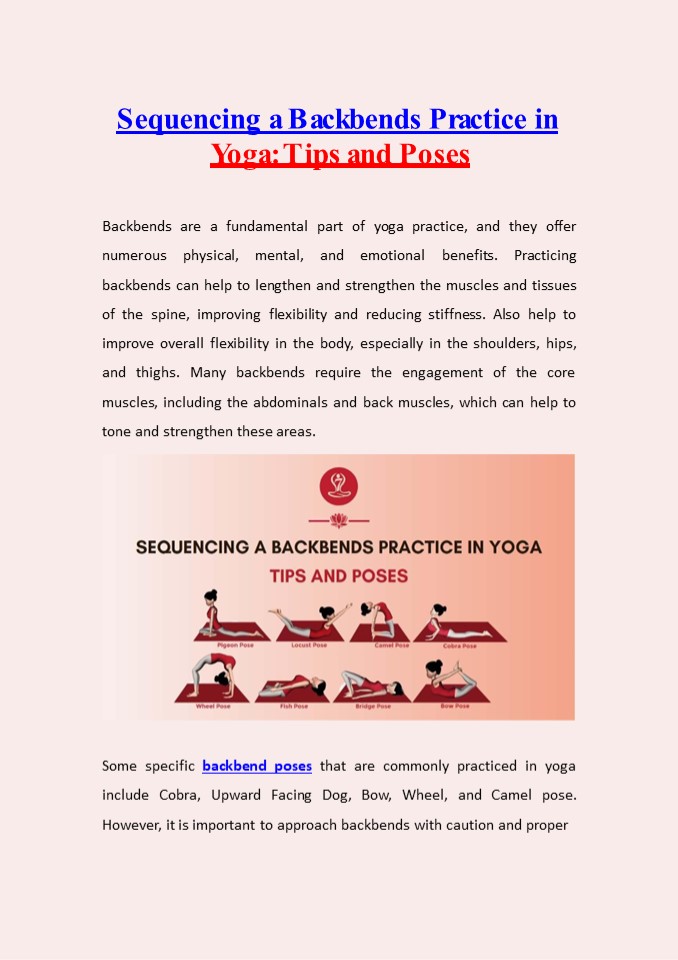Sequencing a Backbends Practice in Yoga: Tips and Poses PowerPoint PPT Presentation
Title: Sequencing a Backbends Practice in Yoga: Tips and Poses
1
Sequencing a Backbends Practice in Yoga Tips
and Poses
Backbends are a fundamental part of yoga
practice, and they offer numerous physical,
mental, and emotional benefits. Practicing
backbends can help to lengthen and strengthen the
muscles and tissues of the spine, improving
flexibility and reducing stiffness. Also help to
improve overall flexibility in the body,
especially in the shoulders, hips, and thighs.
Many backbends require the engagement of the core
muscles, including the abdominals and back
muscles, which can help to tone and strengthen
these areas.
Some specific backbend poses that are commonly
practiced in yoga include Cobra, Upward Facing
Dog, Bow, Wheel, and Camel pose. However, it is
important to approach backbends with caution and
proper
2
- alignment to avoid injury and to work gradually
toward more advanced poses as your strength and
flexibility improve. - Gentle Yoga Backbends Poses How to Get Practice
- Some common backbend yoga poses include Cobra,
Upward Facing Dog, Bridge, Wheel, and Camel
pose. Practicing these poses regularly can offer
numerous physical, mental, and emotional benefits - Here learn more about the safety tips and poses,
and sequencing suggestions for gentle backbends. - Cobra Pose (Bhujangasana)
- Benefits Stretches the chest, shoulders, and
abdomen, strengthens the back muscles, and
improves posture. - Steps
- Lie on your stomach with your hands under your
shoulders. - Press your palms into the floor and lift your
chest up, keeping your shoulders down and away
from your ears. - Hold for a few breaths, then release.
- Upward Facing Dog Pose (Urdhva Mukha Svanasana)
3
- Steps
- Start in a plank position with your hands under
your shoulders and your feet hip-width apart. - Slowly lower down, keeping your elbows close to
your body, until your thighs and hips are on the
ground. - Press into your hands and lift your chest up,
keeping your shoulders - down and away from your ears.
- Hold for a few breaths, then release.
- Bow Pose (Dhanurasana)
- Benefits Stretches the chest, shoulders, and
thighs, strengthens the back muscles, and
improves posture. - Steps
- Lie on your stomach with your arms at your sides.
- Bend your knees and reach your hands back to grab
your ankles. - Lift your chest and thighs off the ground,
keeping your knees hip- width apart. - Hold for a few breaths, then release.
- Wheel Pose (Chakrasana)
4
- Lie on your back with your knees bent and your
feet flat on the ground. - Place your hands by your ears, fingers pointing
toward your shoulders. - Press into your hands and feet and lift your hips
and chest up, keeping your elbows parallel. - Hold for a few breaths, then release.
- Camel Pose (Ustrasana)
- Benefits Stretches the chest, shoulders, and
thighs, improves flexibility in the spine and
hips, and strengthens the back muscles. - Steps
- Kneel on the ground with your knees hip-width
apart. - Place your hands on your lower back and lift your
chest up. - Reach your hands back to grab your heels, keeping
your hips over your knees. - Hold for a few breaths, then release.
- Backbends yoga poses are an important part of a
balanced yoga routine that can improve
flexibility, strengthen the muscles of the back
and core, and promote healthy spinal alignment. - Conclusion
5
Overall, backbend yoga can be a challenging yet
rewarding practice that offers a variety of
benefits for the mind, body, and spirit. It is
important to approach the above poses with
caution and proper alignment to avoid injury and
to work gradually toward more advanced poses as
your strength and flexibility improve. Source
link https//www.vingle.net/posts/5811024

